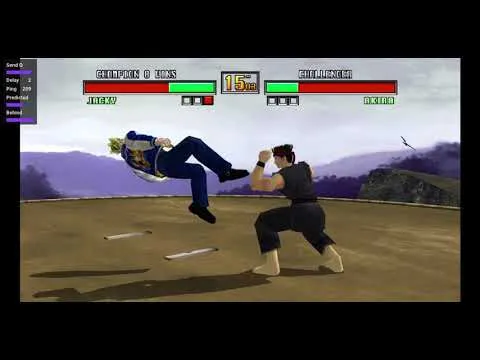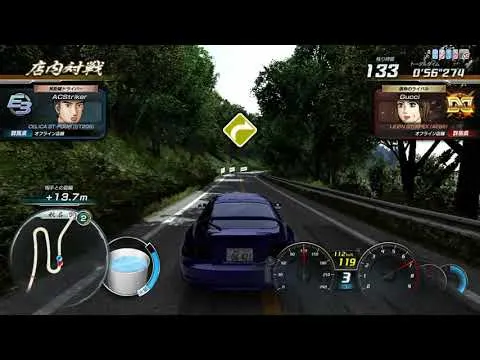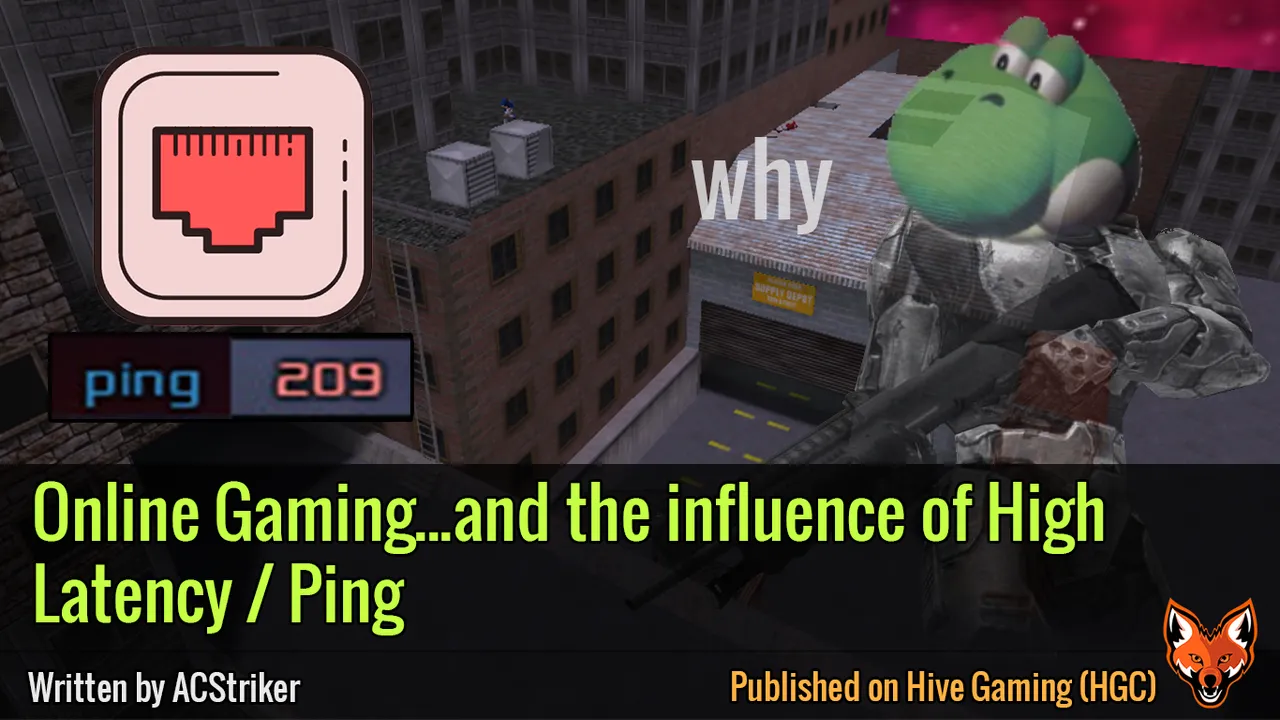
Everybody likes when a game has a well-made multiplayer, since it means that it can be enjoyed with friends; the arrival of Online Multiplayer since the 90s on PC games (and starting to become widespread in consoles as early as the sixth generation) allowed for a shift in paradigm to be able to make friends all over the world, as well as put your skills to test with strangers anytime, and also have the convenient option to play with any of your real-life buddies but each one being at the comfort of their own home. And with the pandemic that had arrived in 2020, online multiplayer turned more significant than ever.
However, depending of the games that you have played, your own localization, and having played with certain players from countries far away from you, you might have stumbled with, at best, little to no hiccups with small oddities, but at worst, having the gameplay being severely affected or even becoming virtually unplayable...and at most, this can be related to two things: Netcode and Latency...but latency is often called "Ping", as it describes the time it takes for one computer's response to reach the other side and viceversa. To provide context on some of my next points, the term "input delay" is about how much it takes between a button/key being pressed and the game actually recognizing that input to make an action. While this can exist offline, for any emulators and games using delay-based netcode for netplay, this means that the higher the distance/ping, the higher the input delay will be...which can be a nuisance depending of the game.
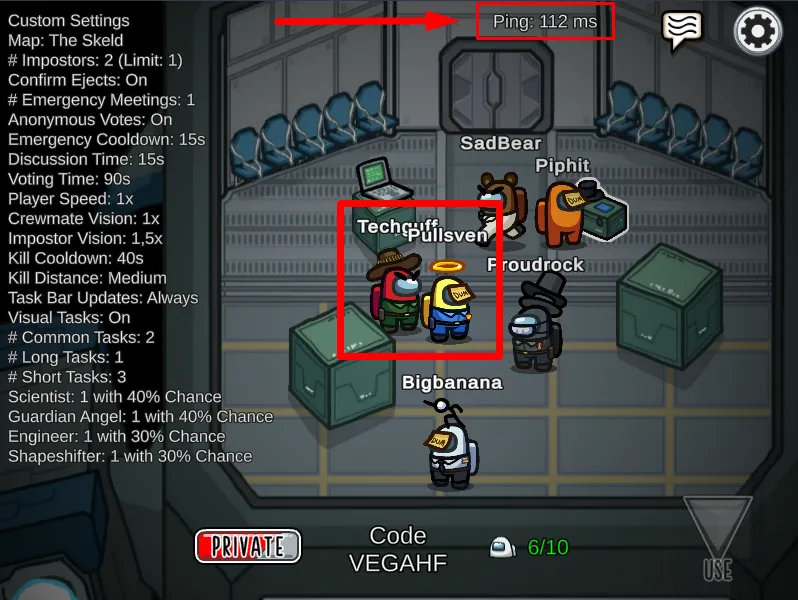
Marked at the top of the screen is a Ping counter for Among Us, which in this case is regarding your connection with the server. Pay no attention to the frame where I'm clearly attempting to capture the worst criminal and imposter in the game though...
The netcode is definitely an influential factor on an online game's performance as it can either be well optimized to handle long distances (Rollback on Fighting Games is one great example of how transitioning from an old approach to a new one can really help players on their experience), finding creative ways to synchronize while keeping what you see smooth enough...or fail to do any of these and have a range of visible issues or severe slowdown. This is where the real focus of today's post is going to be, as Latency/Ping can have a myriad of effects depending of how much you have, and what game's approach to netcode is...and sometimes there is no way to lower your own ping, so you're forced to find which games will not let you in the worst conditions possible when trying to play online.
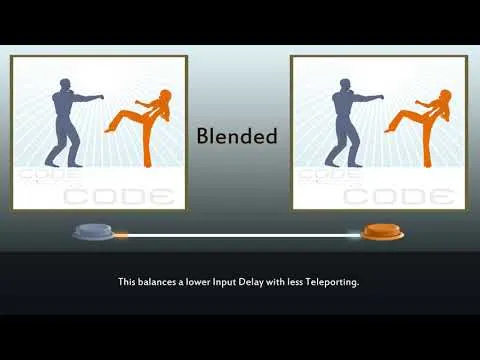
That one Code Mystics video explaining rollback, which I might have used already a couple of times. It still happens to explain pretty well how it varies from the usual delay netcode and why it ends up reducing visible lag drastically.
As a fighting game fan from Venezuela, high latency is something that can be a struggle to deal with and can't even do much about it, as either connection with most countries might be from 180ms and above or ping, and even though I can have better results playing with certain US players, my own internet speed (max download is 240kb/s) can also be an obstruction; sometimes playing with certain Venezuelan buddies online also could present shaky ping exactly because of issues between either one of our connections. Well-optimized rollback in games like Skullgirls and Killer Instinct, as well as in unofficial options like Fightcade have allowed me to play with people around the world without any issues. It can still be hard to find players at times because of most players refusing to play with high ping, but in any case it makes games with close and far buddies altogether much better.
Footage of me Virtua Fighter 3 with an USA player with JUST 2 FRAMES of input delay. The addition of rollback to Flycast (which is now integrated into Fightcade) was truly a game-changer to play Dreamcast and NAOMI games online; specially for me!
With delay-based netcode fighting games on the other hand...not only forced high input delay or poor netcode causes the game either be playable under bad conditions or even too laggy to be playable, like with Tekken 7 (BECAUSE THE ROLLBACK NETCODE THEY PROMISED WAS VIRTUALLY NOTHING...sorry about that, I had got that game on a sale because of that blurb in Season 4's trailer last year, but clearly got ripped off). I would be lucky to ever find anyone that accepted playing with me but resulting in a laggy match. Only times I could play that game with good online was specifically with Venezuelan players at 1am...so yeah, I'm basically screwed for finding matches on that game.
One of the only times I could play Tekken 7 online properly and the only recording I have of that (the graphics are lowered because of my own specs); at least it was satisfying fun to play like this even though I got crushed.
With FPS games, the ordeal can be weirder depending of the game, as approaches to netcode can vary even more from the game's developers to the game's age, as well as your own ping to the server instead of another specific player, and for example, the original Halo Combat Evolved and Custom Edition on PC worked fine for me online most of the time...but when there was huge lag, it would show with my character's movement being rolled back every second (say, you walk forward four steps...and then you would go back two). With Counter-Strike, high ping can make other players look skippy (which can be an issue when sniping, for an example). In both cases, with big ping spikes, you can end up temporarily frozen, which might even get you killed if it happens during a firefight.
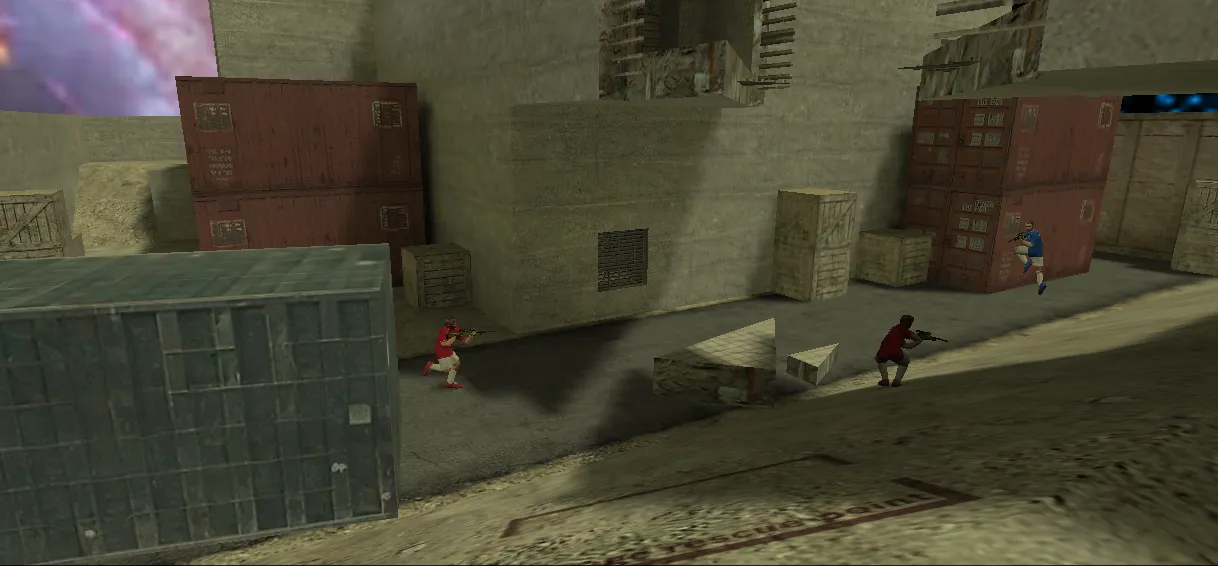
A photo of few days ago where I was playing Counter-Strike 1.6 with some buddies from HiveGaming; this is the best screenshot I got because I only ended up taking screenshots from when I was dead and spectating lol
Another game where I found an interesting side-effect was in Quake 3 and Xonotic; both Arena FPS where fast movement and mechanics like rocket-jumping and bunny hopping are emphasized. In the case of Quake 3 (and OpenArena), aside from the occasional enemy skipping, your movement is entirely unaffected, and while your firing animation and sounds would be instant, the higher the ping, the more delayed your attack would actually be. Xonotic also presents this delay, but the firing animation/sound actually get delayed, so it feels more like your trigger being delayed instead of your weapon bullets coming out late. On Real-Time Strategy games like Age of Empires and Warcraft III, you could also experience delay when moving your units and such, but there's way more emphasizing on your own strategies and decision taking instead of fast reflexes, so it is less impactful.
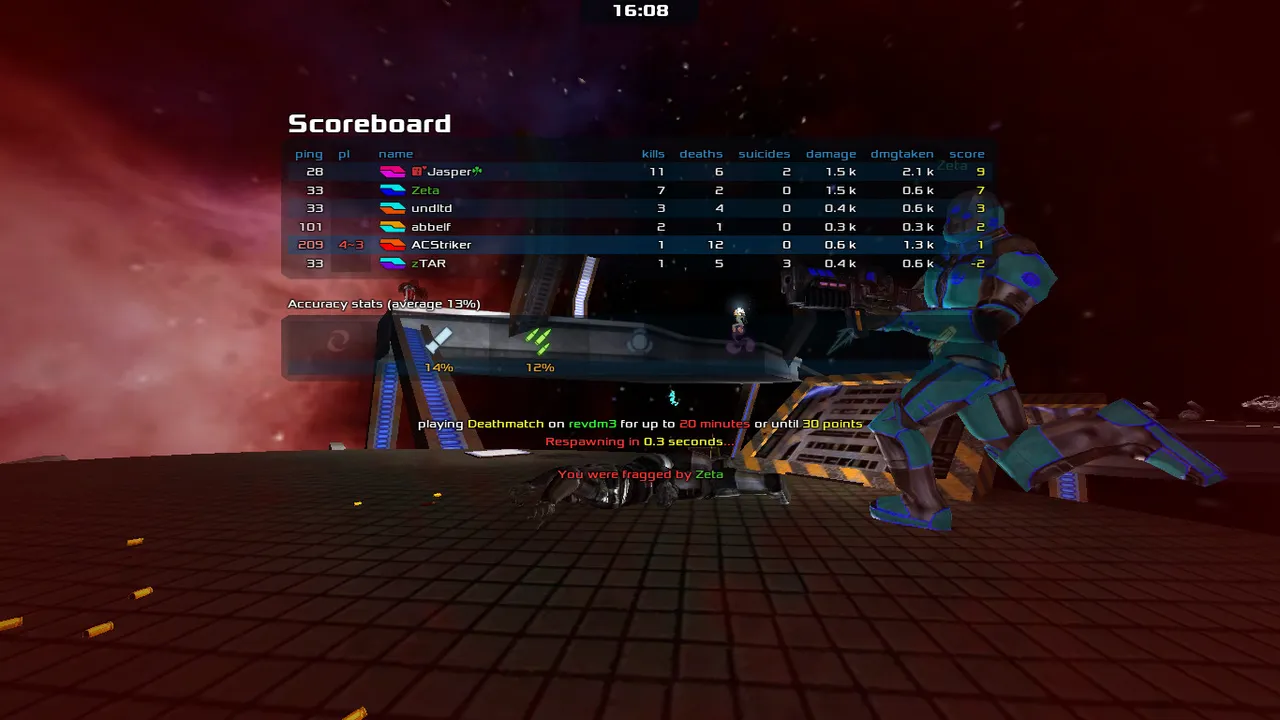
On the other hand, as a positive counterpart of what happend with fighting games, any online turn-based games (from board games to stuff like Worms and golfing games) are very likely to work completely fine because no work needs to be done to keep players syincing at the same time, so even with ping, you should be able to do your own turn without any side effects on controls, and you will be able to see the other player actions as well.
Racing games can be a bit more complicated, as most have to account for collisions between other cars, and approaches to synchronizing players can be different. While I haven't tried out any modern racing games online (...because I don't have access to any), with games like Outrun 2006, Initial D Arcade Stage 8 and Burnout Legends (on PPSSPP) having their netcodes intended for local networking...but still being playable online over long distances. The only big side effect is that other player cars will definitely look weird, either updating their position at a choppy rate or spinning out wildly depending othe game, but at least it does allow me to have fun online. If there are racing games that slow down everybody online from one player's lag or something like that, I haven't stumbled upon such a case, so if anyone can tell me about laggy experiences with racing games, let me know in the comments.
Footage of Initial D Arcade Stage 8, an Arcade game playable through a special launcher. While this game's multiplayer was intended to be used between linked local cabinets, it works perfectly fine through Radmin VPN! I don't know where the other player was from, but it worked pretty well!
In any case, in some genres the input latency will only affect how you see the other player, but your own controls and experience will be fine, while in others, it might be fine for casual players or people that are willing to play in any conditions because they don't have any other choice (this is me playing fighting games with 6-10 frames of input delay and FPS games at 200 ping lol), but for very skilled players, high latency can ruin their experience...and with specific games, no matter what you do, having high ping WILL be unplayable (I'm still looking at you Tekken 7, I'm not going to EVER forget that betrayal).
But hey, each one to their own experience and fun, because I'm glad that most games that I had the chance to play online were playable enough, with or without side effects, if not because they are fun games that I wouldn't often have the chance to play with someone otherwise (and I also use an Ethernet cable, which is always said to be mandatory to have stable connections when playing online). It was fun to write about about some of the weird things that I have encountered either from bad netcode or just poor luck of any other players ever avaliable being quite far away, but those moments make me appreciate even more the ones where I can play without any issues! 😄
And of course, shout-outs to my buddies at Hive Gaming Community for these recent gaming nights with Among Us, Counter Strike 1.6 and Halo Custom Edition (@rishahp, @therealflaws, @perceval, @stk-g, @digitaldicast, @mig1, @sadbear, @ikasumanera, @gabrielserra); it has been amazing to play with you all and I'm looking forward to more gaming nights like those! I might as well try writing some of the funniest stuff I saw from those, but I didn't get to take many screenshots from those games 😅
Spanish translation with DeepL. All screenshots were captured by myself.
Español

A todo el mundo le gusta que un juego tenga un multijugador bien hecho, ya que significa que se puede disfrutar con amigos; la llegada del multijugador online desde los años 90 en los juegos de PC (y empezando a generalizarse en las consolas ya en la sexta generación) permitió un cambio de paradigma al poder hacer amigos en todo el mundo, así como poner a prueba tus habilidades con desconocidos en cualquier momento, y además tener la cómoda opción de jugar con cualquiera de tus compañeros de la vida real pero estando cada uno en la comodidad de su casa. Y con la pandemia que llegó en 2020, el multijugador en línea cobró más importancia que nunca.
Sin embargo, dependiendo de los juegos a los que hayas jugado, de tu propia localización, y de haber jugado con ciertos jugadores de países lejanos a ti, puedes haber tropezado con, en el mejor de los casos, pocos o ningún contratiempo con pequeñas rarezas, pero en el peor de los casos, tener la jugabilidad muy afectada o incluso llegar a ser prácticamente injugable... y como mucho, esto puede estar relacionado con dos cosas: El Netcode y la Latencia...pero la latencia se suele llamar "Ping", ya que describe el tiempo que tarda la respuesta de un ordenador en llegar al otro lado y viceversa. Para contextualizar algunos de mis próximos puntos, el término "retardo de entrada" se refiere a lo que tarda entre que se pulsa un botón/tecla y el juego reconoce realmente esa entrada para realizar una acción. Mientras que esto puede existir fuera de línea, para cualquier emulador y juegos que usen un código de red basado en el retardo para el juego en red, esto significa que cuanto mayor sea la distancia/el ping, mayor será el retardo de entrada... lo que puede ser una molestia dependiendo del juego.

En la parte superior de la pantalla hay un contador de Ping para Among Us, que en este caso se refiere a tu conexión con el servidor. Sin embargo, no prestes atención al fotograma en el que claramente intento capturar al peor criminal e impostor del juego....
El netcode es definitivamente un factor influyente en el rendimiento de un juego online, ya que puede estar bien optimizado para manejar largas distancias (Rollback en los juegos de lucha es un gran ejemplo de cómo la transición de un enfoque antiguo a uno nuevo puede ayudar realmente a los jugadores en su experiencia), encontrando formas creativas de sincronización mientras se mantiene lo que se ve lo suficientemente suave... o no hacer nada de esto y tener una serie de problemas visibles o una grave ralentización. Aquí es donde va a estar el verdadero enfoque del post de hoy, ya que la Latencia/Ping puede tener una miríada de efectos dependiendo de la cantidad que tengas, y del enfoque del juego en cuanto al netcode...y a veces no hay manera de bajar tu propio ping, por lo que te ves obligado a encontrar qué juegos no te dejarán en las peores condiciones posibles al intentar jugar online.

Ese video de Code Mystics explicando el rollback, que puede que haya usado ya un par de veces. Igual explica bastante bien cómo varía del netcode de retardo habitual y por qué acaba reduciendo el lag visible de forma drástica.
Como fanático de los juegos de lucha en Venezuela, la alta latencia es algo que puede ser una lucha para lidiar con ella y no se puede hacer mucho al respecto, ya que la conexión con la mayoría de los países puede ser de 180ms y más o ping, y aunque puedo tener mejores resultados jugando con ciertos jugadores de Estados Unidos, mi propia velocidad de Internet (la descarga máxima es de 240kb/s) también puede ser un obstáculo; a veces jugando con ciertos amigos venezolanos en línea también podría presentar ping inestable exactamente debido a los problemas entre cualquiera de nuestras conexiones. El rollback bien optimizado en juegos como Skullgirls y Killer Instinct, así como en opciones no oficiales como Fightcade me han permitido jugar con gente de todo el mundo sin ningún problema. Todavía puede ser difícil encontrar jugadores a veces debido a que la mayoría de los jugadores se niegan a jugar con un ping alto, pero en cualquier caso hace que las partidas con compañeros cercanos y lejanos sean mucho mejores.
*Formación de mí Virtua Fighter 3 con un jugador de EE.UU. con SOLO 2 FRAMES de retraso de entrada. La adición del rollback a Flycast (que ahora está integrado en Fightcade) fue realmente un cambio de juego para jugar a los juegos de Dreamcast y NAOMI en línea; ¡especialmente para mí!
Por otro lado, con los juegos de lucha basados en el retardo de la red... no sólo el retardo de entrada forzado o un mal código de red hace que el juego sea jugable en malas condiciones o incluso demasiado lento para ser jugable, como con Tekken 7 (PORQUE EL CÓDIGO DE RED DE RETORNO QUE PROMETIERON ERA VIRTUALMENTE NADA... Lo siento, había conseguido ese juego en una oferta debido a ese anuncio en el tráiler de la Temporada 4 el año pasado, pero claramente fui estafado). Tendría suerte si alguna vez encontrara a alguien que aceptara jugar conmigo, pero el resultado era una partida con lag. Las únicas veces que pude jugar a ese juego con buen online fue específicamente con jugadores venezolanos a la 1 de la mañana... así que sí, estoy básicamente fregado para encontrar partidas en ese juego.
Una de las únicas veces que pude jugar a Tekken 7 online correctamente y la única grabación que tengo de ello (los gráficos están rebajados por mis propias especificaciones); al menos fue una diversión satisfactoria jugar así aunque me machacaran.
Con los juegos FPS, el calvario puede ser más extraño dependiendo del juego, ya que los enfoques del código de red pueden variar aún más de los desarrolladores del juego a la edad del juego, así como su propio ping al servidor en lugar de otro jugador específico, y por ejemplo, el original Halo Combat Evolved y Custom Edition en PC funcionó bien para mí en línea la mayor parte del tiempo ... pero cuando había lag enorme, se mostraría con el movimiento de mi personaje que se rodó hacia atrás cada segundo (digamos, usted camina hacia adelante cuatro pasos ... y luego volvería dos). En Counter-Strike, un ping alto puede hacer que los otros jugadores parezcan saltar (lo que puede ser un problema a la hora de disparar, por ejemplo). En ambos casos, con grandes picos de ping, puedes acabar temporalmente congelado, lo que incluso puede hacer que te maten si ocurre durante un tiroteo.

Una foto de hace unos días donde estaba jugando Counter-Strike 1.6 con algunos amigos de HiveGaming; esta es la mejor foto que tengo porque solo tomé fotos cuando estaba muerto y de espectador lol
Otro juego en el que encontré un efecto secundario interesante fue en Quake 3 y Xonotic; ambos FPS de Arena en los que se enfatizan los movimientos rápidos y las mecánicas como el salto de cohete y el salto de conejo. En el caso de Quake 3 (y OpenArena), aparte de los ocasionales saltos de los enemigos, tu movimiento no se ve afectado en absoluto, y aunque tu animación de disparo y los sonidos serían instantáneos, cuanto más alto sea el ping, más se retrasará tu ataque. Xonotic también presenta este retraso, pero la animación y el sonido de disparo se retrasan realmente, por lo que parece más bien que tu gatillo se retrasa en lugar de que las balas de tu arma salgan tarde. En los juegos de estrategia en tiempo real, como Age of Empires y Warcraft III, también puedes experimentar un retraso al mover tus unidades y demás, pero se hace más hincapié en tus propias estrategias y en la toma de decisiones en lugar de en los reflejos rápidos, por lo que es menos impactante.

Por otro lado, como contrapartida positiva de lo que ocurrió con los juegos de lucha, cualquier juego online por turnos (desde juegos de mesa hasta cosas como Worms y juegos de golf) es muy probable que funcione completamente bien porque no hay que hacer ningún trabajo para mantener a los jugadores sintonizados al mismo tiempo, así que incluso con ping, deberías ser capaz de hacer tu propio turno sin ningún efecto secundario en los controles, y también podrás ver las acciones de los otros jugadores.
Los juegos de carreras pueden ser un poco más complicados, ya que la mayoría tienen que tener en cuenta las colisiones entre otros coches, y los enfoques para sincronizar a los jugadores pueden ser diferentes. Aunque no he probado ningún juego de carreras moderno en línea (...porque no tengo acceso a ninguno), con juegos como Outrun 2006, Initial D Arcade Stage 8 y Burnout Legends (en PPSSPP) que tienen sus códigos de red pensados para la conexión en red local...pero que siguen siendo jugables en línea a larga distancia. El único efecto secundario es que los coches de los otros jugadores se verán de forma extraña, actualizando su posición a un ritmo entrecortado o girando salvajemente dependiendo del juego, pero al menos me permite divertirme en línea. Si hay juegos de carreras que ralentizan a todo el mundo online por el lag de un jugador o algo así, no me he topado con un caso así, así que si alguien puede contarme experiencias de lag con juegos de carreras, que me lo diga en los comentarios.
Imágenes de Initial D Arcade Stage 8, un juego Arcade que se puede jugar a través de un lanzador especial. Aunque el multijugador de este juego estaba pensado para ser utilizado entre armarios locales conectados, ¡funciona perfectamente a través de Radmin VPN! No sé de dónde era el otro jugador, pero funcionó bastante bien.
En cualquier caso, en algunos géneros la latencia de entrada sólo afectará a cómo ves al otro jugador, pero tus propios controles y experiencia estarán bien, mientras que en otros, puede estar bien para jugadores casuales o gente que está dispuesta a jugar en cualquier condición porque no tienen otra opción (este soy yo jugando a juegos de lucha con 6-10 frames de retardo de entrada y juegos FPS a 200 de ping lol), pero para jugadores muy hábiles, la alta latencia puede arruinar su experiencia. ...y con juegos específicos, no importa lo que hagas, tener un ping alto será injugable (Todavía te estoy mirando a ti Tekken 7, no voy a olvidar NUNCA esa traición).
Pero bueno, cada uno con su experiencia y diversión, porque me alegro de que la mayoría de los juegos que he tenido la oportunidad de jugar online hayan sido lo suficientemente jugables, con o sin efectos secundarios, si no es porque son juegos divertidos que de otra manera no tendría muchas veces la oportunidad de jugar con alguien (y también uso un cable Ethernet, el cual siempre se dice que es necesario para tener una conexión estable jugando online). Ha sido divertido escribir sobre algunas de las cosas raras que me he encontrado, ya sea por un mal netcode o simplemente por la mala suerte de que haya otros jugadores disponibles estando bastante lejos, ¡pero esos momentos me hacen apreciar aún más aquellos en los que puedo jugar sin problemas! 😄
Y, por supuesto, un saludo a mis compañeros de Hive Gaming Community por estas recientes noches de juego con Among Us, Counter Strike 1.6 y Halo Custom Edition (@rishahp, @therealflaws, @perceval, @stk-g, @digitaldicast, @mig1, @sadbear, @ikasumanera, @gabrielserra); ¡ha sido increíble jugar con todos vosotros y estoy deseando que haya más noches de juego como esas! También podría intentar escribir algunas de las cosas más divertidas que vi de aquellas, pero no pude hacer muchas capturas de pantalla de esos juegos 😅
Traducción al español hecha con DeepL. Todas las fotos capturadas por mí.
